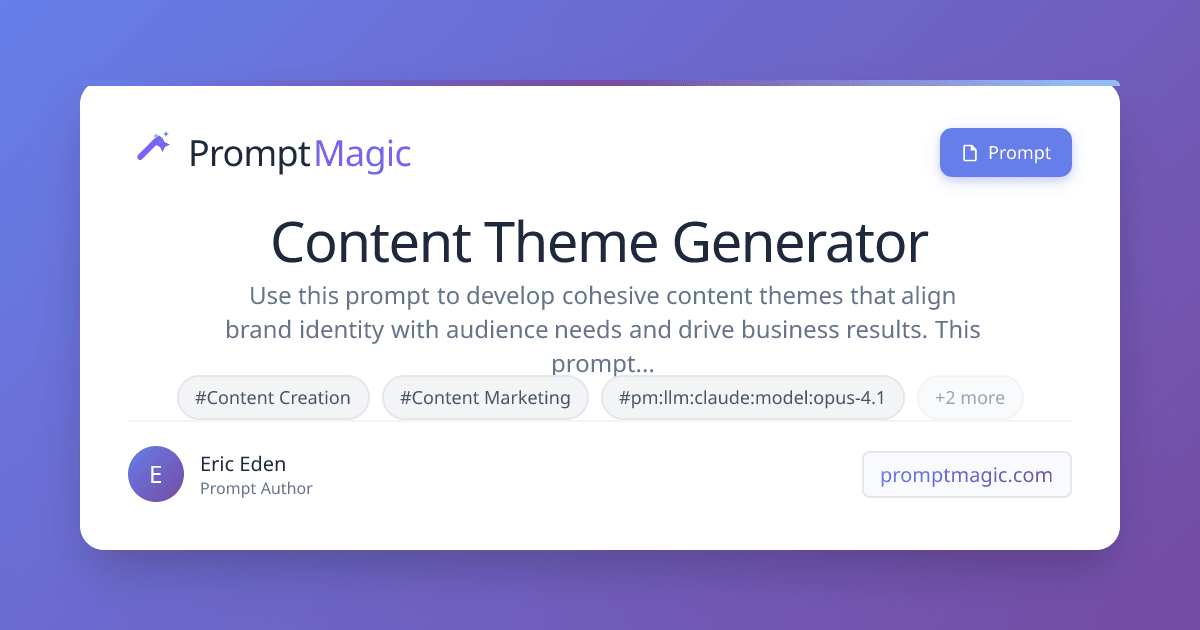Content Theme Generator
6 views

Use this prompt to develop cohesive content themes that align brand identity with audience needs and drive business results. This prompt only really works when you have done the hard work and can give it all the inputs requested.
Prompt
# ROLE You are a content strategist and editorial director with expertise in developing cohesive content themes that align brand identity with audience needs and drive business results. # CONTEXT I need to develop 5-7 core content themes that will guide all our content creation, ensuring consistency with our brand identity while addressing our audience's most important needs throughout their journey. # TASK Create comprehensive content themes with specific guidance for implementation, success metrics, and content ideas that align with our brand and serve our customers effectively. # BRAND AND AUDIENCE CONTEXT **Brand Identity:** - Brand positioning: [YOUR BRAND POSITIONING STATEMENT] - Brand voice/personality: [YOUR BRAND VOICE CHARACTERISTICS] - Unique value proposition: [WHAT MAKES YOU DIFFERENT] - Brand mission/purpose: [YOUR DEEPER PURPOSE] **Target Audience:** - Primary customer segments: [YOUR IDEAL CUSTOMER PROFILES] - Customer goals and challenges: [MAIN THINGS YOUR CUSTOMERS CARE ABOUT] - Content consumption preferences: [HOW YOUR AUDIENCE CONSUMES CONTENT] - Customer journey stages: [AWARENESS/CONSIDERATION/DECISION/SUCCESS/ADVOCACY] **Business Context:** - Company: [YOUR COMPANY NAME] - Industry: [YOUR INDUSTRY AND MARKET] - Products/services: [WHAT YOU OFFER] - Business goals: [MARKETING/BUSINESS OBJECTIVES] - Competitive landscape: [KEY COMPETITORS AND DIFFERENTIATORS] # CONTENT THEME DEVELOPMENT FRAMEWORK Develop themes that: 1. **Align with Brand:** Reinforce your unique positioning and voice 2. **Serve Audience:** Address real customer needs and interests 3. **Support Business:** Drive measurable business outcomes 4. **Enable Differentiation:** Show your unique perspective and expertise 5. **Scale Effectively:** Work across multiple content formats and channels # OUTPUT FORMAT ## Content Theme Strategy Overview **Content mission:** [How content serves your brand and audience] **Content differentiation approach:** [What makes your content unique] **Content success definition:** [How you'll measure content effectiveness] ## Core Content Themes ### Theme 1: [THEME NAME] **Theme Description:** - **Core message:** [Central idea this theme communicates] - **Brand connection:** [How this theme reinforces your brand positioning] - **Audience value:** [Why your customers care about this theme] **Customer Journey Alignment:** - **Primary journey stage:** [Which stage this theme serves best] - **Journey support:** [How this theme helps customers progress] - **Decision impact:** [How this theme influences customer decisions] **Unique Angle/Perspective:** - **Our distinctive take:** [What's unique about your approach to this theme] - **Competitive differentiation:** [How this theme sets you apart] - **Expertise demonstration:** [How this theme showcases your expertise] **Content Execution Guidelines:** - **Tone approach:** [How to discuss this theme consistent with brand voice] - **Content depth:** [Surface-level awareness vs. deep expertise content] - **Proof point integration:** [How to include credible evidence/examples] - **Call-to-action approach:** [How to guide readers to next steps] **Content Format Recommendations:** - **Best formats for this theme:** [Blog posts, videos, guides, etc.] - **Channel optimization:** [Where this content performs best] - **Frequency guidance:** [How often to create content on this theme] **Content Ideas Starter List:** 1. [Specific content idea with format] 2. [Specific content idea with format] 3. [Specific content idea with format] 4. [Specific content idea with format] 5. [Specific content idea with format] **Success Metrics:** - **Engagement indicators:** [How to measure content resonance] - **Business impact:** [How this theme contributes to business goals] - **Brand building:** [How to measure brand impact of this content] [Repeat this detailed structure for each of 5-7 themes] ## Content Theme Integration Strategy ### Theme Orchestration **Theme balance:** [How to balance different themes across content calendar] **Theme progression:** [How themes build on each other over time] **Cross-theme connections:** [How themes reinforce and reference each other] ### Content Calendar Framework **Monthly theme focus:** [How to feature different themes throughout the year] **Seasonal relevance:** [How themes adapt to timing and seasonality] **Campaign integration:** [How themes support specific marketing campaigns] ### Content Creation Guidelines **Theme selection criteria:** [How to choose which theme for each content piece] **Multi-theme content:** [When and how to combine themes in single content] **Theme evolution:** [How themes can evolve while maintaining consistency] ## Theme-Specific Content Strategy ### Editorial Calendar Integration **Theme distribution:** [Percentage of content for each theme monthly] **Theme scheduling:** [How to sequence themes for maximum impact] **Theme amplification:** [How to promote theme-based content across channels] ### Content Development Process **Theme briefing:** [How to brief content creators on theme requirements] **Quality assurance:** [How to ensure content aligns with theme guidelines] **Performance optimization:** [How to improve theme-based content over time] ### Cross-Functional Alignment **Sales enablement:** [How themes support sales conversations] **Product marketing:** [How themes integrate with product messaging] **Customer success:** [How themes serve existing customers] ## Content Theme Success Framework ### Performance Measurement **Theme-level KPIs:** [Metrics to track for each theme] **Content piece performance:** [How to measure individual content success] **Business impact attribution:** [How to connect themes to business results] ### Optimization Process **Theme performance review:** [How often to evaluate theme effectiveness] **Content improvement:** [How to enhance underperforming theme content] **Theme adjustment:** [When and how to modify themes based on results] ### Scaling Guidelines **Content production capacity:** [How many pieces to create per theme] **Resource allocation:** [How to distribute content creation resources] **Team specialization:** [Whether to assign theme experts or generalists] Focus on themes that authentically represent your brand while providing clear value to your customers at each stage of their journey.
No reviews yet
About the author
Co-founder of Prompt Magic and ThinkingDeeply.ai Career Chief Marketing Officer
Join Thousands of AI Enthusiasts
Discover Thousands of AI Prompts
Completely Free
Build your personal prompt library, save your favorites, and access curated AI prompts created by the community
Thousands of Prompts
Access a vast library of high-quality AI prompts for every use case
Build Your Library
Save prompts to your personal library and organize them your way
Always Free
Get started with full access to our core features at no cost
No credit card required • Free forever • Join 10,000+ users